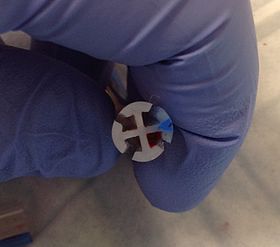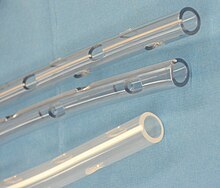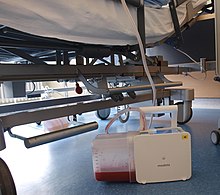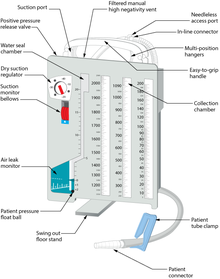
Chest tube
| Chest tube | |
|---|---|
 The free end of the Chest Drainage Device is usually attached to an underwater seal, below the level of the chest. This allows the air or fluid to escape from the pleural space, and prevents anything returning to the chest.
| |
| Other names | Intercostal drain |
| Specialty | pulmonology |
| ICD-9-CM | 34.04 |
| MeSH | D013907 |
A chest tube (also chest drain, thoracic catheter, tube thoracostomy or intercostal drain) is a surgical drain that is inserted through the chest wall and into the pleural space or the mediastinum in order to remove clinically undesired substances such as air (pneumothorax), excess fluid (pleural effusion or hydrothorax), blood (hemothorax), chyle (chylothorax) or pus (empyema) from the intrathoracic space. An intrapleural chest tube is also known as a Bülau drain or an intercostal catheter (ICC), and can either be a thin, flexible silicone tube (known as a "pigtail" drain), or a larger, semi-rigid, fenestrated plastic tube, which often involves a flutter valve or underwater seal.
The concept of chest drainage was first advocated by Hippocrates when he described the treatment of empyema by means of incision, cautery and insertion of metal tubes. However, the technique was not widely used until the influenza epidemic of 1918 to evacuate post-pneumonic empyema, which was first documented by Dr. C. Pope, on a 22-month-old infant. The use of chest tubes in postoperative thoracic care was reported in 1922, and they were regularly used post-thoracotomy in World War II, though they were not routinely used for emergency tube thoracostomy following acute trauma until the Korean War.
Uses
Medical uses of chest tube are as follows:
- Pneumothorax: accumulation of air or gas in the pleural space
-
Pleural effusion: accumulation of fluid in the pleural space
- Chylothorax: a collection of lymph in the pleural space
- Empyema: a pyogenic infection of the pleural space
- Hemothorax: accumulation of blood in the pleural space
- Hydrothorax: accumulation of serous fluid in the pleural space
- Urinothorax: accumulation of urine in the pleural space
Contraindications
Contraindications to chest tube placement include refractory coagulopathy and presence of a diaphragmatic hernia, as well as hepatic hydrothorax. Additional contraindications include scarring in the pleural space (adhesions).
Complications
The most common complication of a chest tube is chest tube clogging. Chest tube clogging is widely recognized in published surveys of surgeons and nurses. In one study, 100% had seen chest tube clogging, and a majority had seen adverse patient outcomes from chest tube clogging. In a prospective observational study, over 36% of patients had chest tube clogging after heart surgery. Chest tube clogging can lead to retained blood around the heart and lungs that can contribute to complications and increase mortality. If a chest tube clogs when the patient is still bleeding they can become hypotensive from tamponade, or develop a large hemothorax. If there is not enough to cause a mechanical compression of the heart or lungs, the resulting inflammatory response to the retained blood can lead to pleural and pericardial effusions and contribute to the triggering of postoperative atrial fibrillation in susceptible individuals.
A common complication after thoracic surgery that arises within 30–50% of patients are air leaks. If a chest tube clogs when there is an airleak the patient will develop a pneumothorax. This can be life-threatening. Here, digital chest drainage systems can provide real time information as they monitor intra-pleural pressure and air leak flow, constantly. Keeping vigilant about chest tube clogging is imperative for the team taking care of the patient in the early postoperative period.
Major insertion complications include hemorrhage, infection, and reexpansion pulmonary edema. Injury to the liver, spleen or diaphragm is possible if the tube is placed inferior to the pleural cavity. Injuries to the thoracic aorta and heart can also occur.
When chest tubes are placed due to either blunt or penetrating trauma, antibiotics decrease the risks of infectious complications.
Minor complications include a subcutaneous hematoma or seroma, anxiety, shortness of breath, and cough (after removing large volume of fluid). In most cases, the chest tube related pain goes away after the chest tube is removed, however, chronic pain related to chest tube induced scarring of the intercostal space is not uncommon.
Subcutaneous emphysema indicates backpressure created by undrained air, often caused by a clogged chest tube or insufficient negative pressure. If a patient has subcutaneous emphysema, it is likely their chest tube is not draining and consideration should be given if it should be unclogged or another tube should be placed so that the air leaking from the lung can be adequately drained.
Device
Characteristics
Chest tubes are commonly made from clear plastics like PVC and soft silicone. Chest tubes are made in a range of sizes measured by their external diameter from 6 Fr to 40 Fr. Chest tubes, like most catheters, are measured in French catheter scale. For adults, 20 Fr to 40 Fr (6.7 to 13.3mm external diameter) are commonly used, and 6 Fr to 26 Fr for children. Conventional chest tubes feature multiple drainage fenestrations in the section of the tube which resides inside the patient, as well as distance markers along the length of the tube, and a radiopaque stripe which outlines the first drainage hole. Chest tubes are also provided in right angle, trocar, flared, and tapered configurations for different drainage needs. As well, some chest tubes are coated with heparin to help prevent thrombus formation, though the effect of this is disputed.
Chest tube have an end hole (proximal, toward the patient) and a series of side holes. The number of side holes is generally 6 on most chest tubes. The length of tube that has side holes is the effective drainage length (EDL). In chest tubes designed for pediatric heart surgery, the EDL is shorter, generally by only having 4 side holes.
Channel style chest drains, also called Blake drains, are so-called silastic drains made of silicone and feature open flutes that reside inside the patient. Drainage is thought to be achieved by capillary action, allowing the fluids to travel through the open grooves into a closed cross section, which contains the fluid and allows it to be suctioned through the tube. Though these chest tubes are more expensive than conventional ones, they are theoretically less painful.
Chest drainage system
A chest drainage system is typically used to collect chest drainage (air, blood, effusions). Most commonly, drainage systems use three chambers which are based on the three-bottle system. The first chamber allows fluid that is drained from the chest to be collected. The second chamber functions as a "water seal", which acts as a one way valve allowing gas to escape, but not reenter the chest. Air bubbling through the water seal chamber is usual when the patient coughs or exhales but may indicate, if continual, a pleural or system leak that should be evaluated critically. It can also indicate a leak of air from the lung. The third chamber is the suction control chamber. The height of the water in this chamber regulates the negative pressure applied to the system. A gentle bubbling through the water column minimizes evaporation of the fluid and indicates that the suction is being regulated to the height of the water column. In this way, increased wall suction does not increase the negative pressure of the system. Newer drainage systems eliminate the water seal using a mechanical check-valve, and some also use a mechanical regulator to regulate the suction pressure. Systems which employ both these are dubbed "dry" systems, whereas systems that retain the water seal but use a mechanical regulator are called "wet-dry" systems. Systems which use a water seal and water column regulator are called "wet" systems. Dry systems are advantageous as tip-overs of wet systems can spill and mix with blood, mandating the replacement of the system. Even newer systems are smaller and more ambulatory so the patient can be sent home for drainage if indicated.
The free end of the tube is usually attached to an underwater seal, below the level of the chest. This allows the air or fluid to escape from the pleural space, and prevents anything returning to the chest. Alternatively, the tube can be attached to a flutter valve. This allows patients with pneumothorax to remain more mobile.
More recently digital or electronic chest drainage systems have been introduced. An onboard motor is used as vacuum source along with an integrated suction control canister and water seal. These systems monitor the patient and will alert if the measured data are out of range. Due to the digital control of the negative pressure, the system is able to objectively quantify the presence of a pleural or system leak. Digital drainage systems allow clinicians to mobilize patients early, even for those on continuous suction, which is difficult to accomplish with the traditional water-seal system under suction. Application of such systems can also lead to a reduction in complications.
Technique
Thoracostomy
It can be inserted in an area described as the "safe zone", which is a region bordered by the lateral border of pectoralis major, a horizontal line inferior to the axilla, the anterior border of latissimus dorsi and a horizontal line superior to the nipple. This should translate to the tube being inserted into the fifth intercostal space slightly anterior to the mid axillary line.
Chest tubes are usually inserted under local anesthesia. The skin over the area of insertion is first cleansed with antiseptic solution, such as iodine, before sterile drapes are placed around the area. The local anesthetic is injected into the skin and down to the muscle, and after the area is numb a small incision is made in the skin and a passage made through the skin and muscle into the chest. The tube is placed through this passage. If necessary, patients may be given additional analgesics for the procedure. Once the tube is in place it is sutured to the skin to prevent it falling out and a dressing applied to the area. Once the drain is in place, a chest radiograph will be taken to check the location of the drain. The tube stays in for as long as there is air or fluid to be removed, or risk of air gathering.
Chest tubes can also be placed using a trocar, which is a pointed metallic bar used to guide the tube through the chest wall. This method is less popular due to an increased risk of iatrogenic lung injury. Placement using the Seldinger technique, in which a blunt guidewire is passed through a needle (over which the chest tube is then inserted) has been described.
Protocols to maintain chest tube patency by preventing chest tube clogging are necessary.
Postoperative drainage
The placement technique for postoperative drainage (e.g. cardiac surgery) differs from the technique used for emergency situations. At the completion of open cardiac procedures, chest tubes are placed through separate stab incisions, typically near the inferior aspect of the sternotomy incision. In some instances multiple drains may be used to evacuate the mediastinal, pericardial, and pleural spaces. The drainage holes are placed inside the patient and the chest tube is passed out through the incision. Once the tube is in place, it is sutured to the skin to prevent movement. The chest tube is then connected to the drainage canister using additional tubing and connectors and connected to a suction source, typically regulated to -20 cm of water.
Dressings
After suturing, dressings are applied for hygienical reasons covering the wound. First, a y-slit compress is used around the tube. Second, a compress (10 x 10 cm) is placed on top and finally an adhesive plaster is added in a way that tension is avoided. A bridle rein is recommended to fix the tube to the skin. This tape bridge will prevent the tube from moving backwards and the possibility to cause clogging. It also prevents pain as it reduces tension on the fixation stitch. Alternatively, a large adhesive plaster that functions like a tape bridge may be used.
Management
Chest tubes should be kept free of dependent loops, kinks, and obstructions which may prevent drainage. In general, chest tubes are not clamped except during insertion, removal, or when diagnosing air leaks.
Chest tube clogging with blood clots of fibrinous material is common. When this occurs, it can result in retained blood around the heart or lungs that can lead to complications such as hematoma that needs to be drained, effusions, empyema, or, in the long term, fibrothorax. Thus its critical to maintain chest tube patency. Manual manipulation, often called milking, stripping, fan folding, or tapping, of chest tubes is commonly performed to clear chest tube obstructions. However these approaches are controversial. No conclusive evidence has demonstrated that any of these techniques are more effective than the others, and no method has shown to improve chest tube drainage. Furthermore, chest tube manipulation has proved to increase negative pressure, which may be detrimental, and painful to the patient. For these reasons, many hospitals do not allow these types of manual tube manipulations.
One option is active chest tube clearance without breaking the sterile field. According to a consensus of multiple experts in cardiac surgery, anesthesia and critical care in 2019 the ERAS Guidelines for Perioperative Care recommends active clearance of chest tubes to prevent retained blood and other complications. Makeshift efforts such as open chest tube clearing that involves breaking the sterile environment separating the chest tube from the drainage canister tubing to suction it out should not be performed.
The chest tube can only be removed when the subject clinical condition is stable, the lungs are fully aerated as seen on chest X-ray, chest tube drainage is less than 200 cc per day, and there is no air leak into the lungs pleura.
Side of placement
In December 2018 the European Respiratory Journal published correspondences that raise the possibility of improving mobility as well as patient outcomes by placing a chest tube more optimally.
Further reading
- Catheter drainage is used for empyemas after chest-tube failure: vanSonnenberg E, Nakamoto SK, Mueller PR, Casola G, Neff CC, Friedman PJ, et al. (May 1984). "CT- and ultrasound-guided catheter drainage of empyemas after chest-tube failure". Radiology. 151 (2): 349–353. doi:10.1148/radiology.151.2.6709904. PMID 6709904.
- Commonly used after Percutaneous CT-Guided Lung Biopsies: Saji H, Nakamura H, Tsuchida T, Tsuboi M, Kawate N, Konaka C, Kato H (May 2002). "The incidence and the risk of pneumothorax and chest tube placement after percutaneous CT-guided lung biopsy: the angle of the needle trajectory is a novel predictor". Chest. 121 (5): 1521–1526. doi:10.1378/chest.121.5.1521. PMID 12006438.
External links
-
 Media related to Chest tube at Wikimedia Commons
Media related to Chest tube at Wikimedia Commons
|
Tests and procedures involving the respiratory system
| |||||||||||
|---|---|---|---|---|---|---|---|---|---|---|---|
| Surgery |
|
||||||||||
| Tests |
|
||||||||||
| Other procedures |
|
||||||||||
| Authority control: National |
|---|




